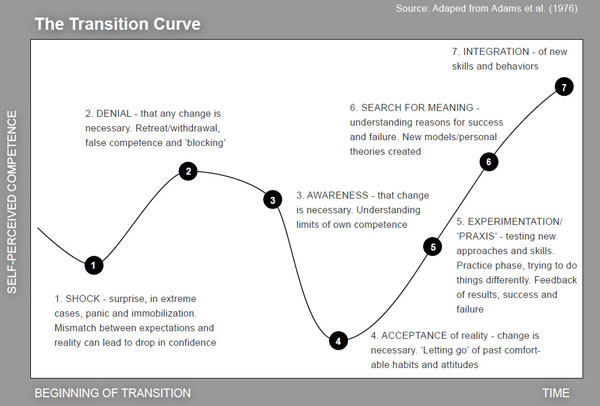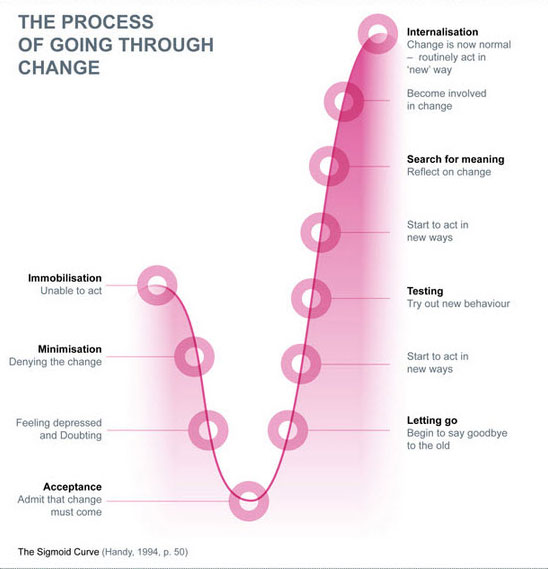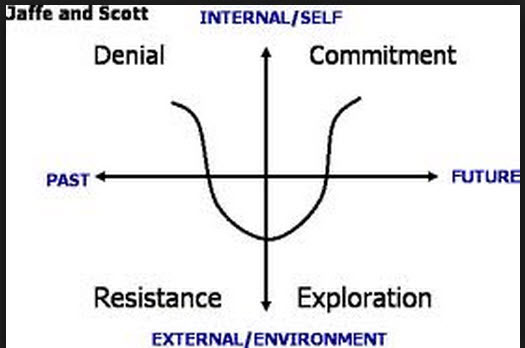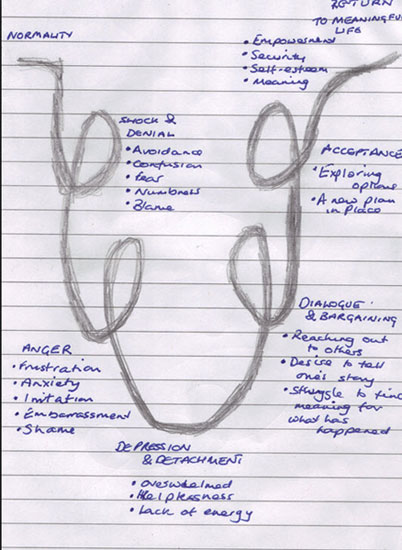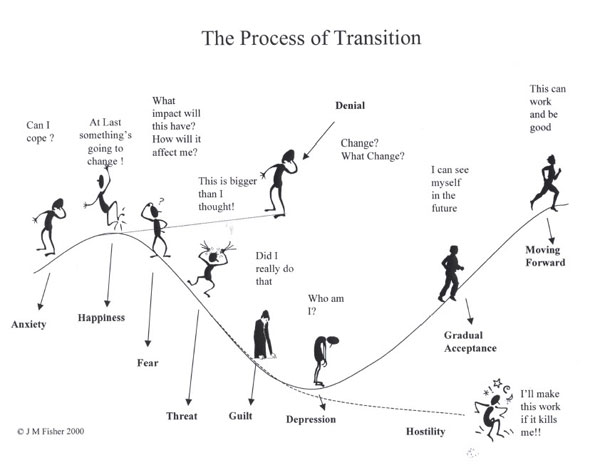Team Development:
Stages of Transition
Overall, the organization has progressed through five of the seven stages of the transition curve. The transition curve tracks the self perceptions of competency during a major shift or change.
Stage 1: SHOCK: The decline in profitability eventually leading to continued losses resulted in the termination of the CEO. Simultaneously, Alix Partners was hired to do a complete cost assessment. The combination of events threw the organization into Stage 1. SHOCK. The person(s) are in total surprise as if they have been disrupted from a trance. In extreme cases, panic and immobilization can occur resulting in a mass departure of talent and a drop of productivity for a large part of the remaining employees. Typically, the perceived gap between expectations and reality can lead to drop in confidence.
It is at this stage that an organization can actually increase its decline because many of the leaders can become immobilized. In this case, the paternal approach of the prior CEO for the senior leadership could have led to a sense of extreme vulnerability in the form of personal and professional exposure.
Stage 2. DENIAL: is the natural reaction for the majority of the organization. Generally, it consists of a disbelief that the condition of the organization is as "bad" as portrayed and/or a denial that any change is necessary. Often, the process involves some form of retreat to memories to create a sense of safety or to complete withdrawal. When retreat occurs, it can manifest a sense of false competence or even 'blocking' the changes necessary to save the organization.
This can appear when some of the leadership team believes that any outside intervention will be more of a nuisance than a supportive analysis. Furthermore, stories of having been through worse or similar situations in the past are offered as evidence that nothing needs to change. The economy will improve or the organization will adjust and come out of the crisis.
Stage 3. AWARENESS: can occur once the fright/shock of the new reality settles in. This tends to be a soul-searching time where many individuals will begin to understand the limits of their own competence. Identity crisis can occur here as self-perceptions surrounding competence are brought into question. Impending reductions in workforce tend to increase this sense of awareness.
Stage 4. ACCEPTANCE: of the reality that change is necessary begins to evolve. Typically, 20% will grasp the need for change immediately, 60-70% will grasp the need for change with time and additional information, and 10-20% will never grasp that change is necessary. 'Letting go' of past comfortable habits and attitudes becomes a strained and disconcerting process because everything is questioned. The quicker the acceptance and shift to a learning perception of opportunity to improve, save the organization, or one's career, the more likely for a successful transition for the individual.
If the individual or group, or entire organization does not fully embrace the reality of the situation, it will show-up in the next stage when the actual change begins to occur.
Stage 5. EXPERIMENTATION/'PRAXIS': The actual change to a new organization and therefore self-perception begins in this stage. Pilot programs and testing new approaches and skills are initiated. People adopt a learning mode of thinking and begin to practice trying to do things differently.
Frustration can be triggered as new forms of feedback is generally resulting in both success and failure as the new processes are tried on. The Knowing-Doing Gap tends to surface as the employees might know the new way of working, but struggle doing it until the new methods are habitualized.
Noteworthy is that at this stage, there is a tendency to regress/revert back to Stage 2 with a strong, false sense of security that nothing needs to change. "We’ve seen this before and weathered it" is a typical type of statement made. Or, with the pressure off from cost cutting or staff reductions, there is a false sense of relief, which triggers unconscious, old habits to quickly regain control of "how we do things". Without strong, objective awareness by senior leaders, this regression will seal the fate of the organization while feeling fully justified in their behavior.
Stage 6. SEARCH FOR MEANING: involves a shift from a sense of danger, discomfort, and disruption to a true understanding of reasons for success and failure. New models/personal theories are created about the self, the organization, and the potential for a future. A broader sense of awareness of what was wrong and how the new processes are beginning to not only make sense but to make a difference in performance.
Stage 7. INTEGRATION: involves alignment with a new set of skills and behaviors that are congruent with the new organization. Self identity evolves into a new form while the organization shapes the new mission, vision, and values. Broader leadership skills begin to evolve as the transition has awakened a larger sense of self and how one fits into the organization.
